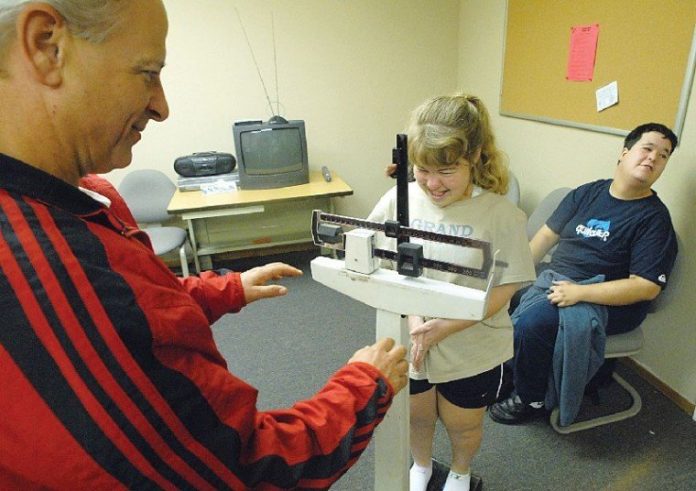Twenty-two months ago, Dominic Gagliardi’s biggest impediment in
life was not his mental handicap, but his eating habits.
Twenty-two months ago, Dominic Gagliardi’s biggest impediment in life was not his mental handicap, but his eating habits.
His junk food-laden diet and sedentary lifestyle left him so overweight that he was unable to walk a block-and-a-half without getting winded. But he rarely walked anyway, as he was usually pushed around in a wheelchair to save him the effort.
Watching Gagliardi now, striding along on a treadmill – his head snaking back and forth involuntarily, fingers twiddling nonstop, mouth frozen in a blissful smile – there is little sign of his former condition. Gagliardi lost 65 pounds in two years, allowing him to ditch the wheelchair, thanks to a new exercise and nutrition program at the Gilroy-based South County Post Secondary School.
The school takes 18- to 22-year-olds with mental retardation and helps them learn life skills. They are taught how to be good employees – bagging purchases at big retailers or stocking video store shelves – how to deposit or withdraw money, and order at a restaurant.
“We want them to be able complete the tasks that most of us take for granted,” said special education teacher Steve Fortino, who heads the program and introduced the health components.
But teaching these skills became more difficult over the years as students, like Gilroy as a whole, became heavier and more out of shape. This made students lethargic at their jobs and slow to move from one place to the next.
“We couldn’t run our program because so much of our day is walking in the community,” said Fortino, who bursts with enthusiasm.
Over about a year, Fortino built up an exercise and nutrition program that now features three hours of swimming, using exercise equipment and weights, and taking aerobics and yoga classes.
In addition, the students shop for and prepare their own lunches, which use fresh vegetables and low-fat meats like fish and chicken.
The program’s 11 young men and women – many of whom also live with physical handicaps, such as restricted mobility or chronic respiratory problems – grin when they talk about the 155 pounds they collectively lost in two years.
My parents “think I look smaller and they take me shopping for new clothes every month,” said Kamaria Broussard.
Fortino then asked her what her major obstacle was to looking like Halle Berry, who she idolizes.
“Only candy,” she shot back, giving a playful slap to his desk. “But I gave that up cold turkey.”
Weight loss is not the only gain students have seen, said Hebe Navarro, aerobics coordinator at Gilroy Health and Fitness.
“It’s not just a physical thing, it’s a metaphysical thing that I’ve seen grow,” she said.
Many students have taken Navarro’s aerobics classes twice a week for more than a year.
They’ve improved “their mobility, their range of motion, their balance – they’ve (advanced) by leaps and bounds,” she said.
The effects of regular exercise on student health have been dramatic, Fortino said. But more surprising was the effect exercise classes – which provide practice following instructions and the increased blood flow to the brain – had on students’ mental functioning.
“I expected all the students to drop some weight, I expected the students to feel better,” he said. “What we’re finding is on the testing that we do, they’re doing better. Not that we’re curing the disease, but we’re making them as sharp as they can be.”
In addition to increased mental acumen and physical fitness, students have gone through emotional changes, said Janet Vanderhoof. Vanderhoof’s 21-year-old son, Blake, lost 34 pounds in the program and went from a size-38 to size-31 pant waist.
“He’s just more outgoing, just brighter and happier, always wanting to do something,” she said. “He just has more energy”
The program has changed the way she looked at taking care of her son, Vanderhoof said.
“Parents with these kids, they tend to just let them just hang around and watch TV and not be active,” she said. The program made “me look at (Blake) differently in the future. I’ll always have to incorporate exercise in his life. It saves our kids lives and it makes them live longer.”














